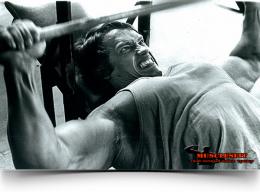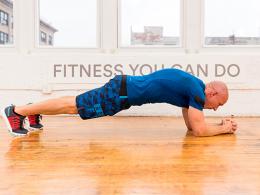How to gain body weight? Comprehensive weight gain program for underweight people (1-2 weeks).
The problem of weight gain is very relevant among young people. Research results indicate that underweight occurs in 15-17% of the population under 35 years of age. This comprehensive mass gaining technique is designed for girls and women who suffer from excessive thinness and for men of all ages who seek to build muscle and have an athletic figure.
The mass gain program is designed for 10 weeks. For convenience, the course is divided into 5 stages of 2 weeks each, each of which has its own characteristics - nutritional norms and physical exercises. This article is a step-by-step instruction that will help you build muscle mass intensively and safely. After you complete the entire course, you can repeat it, feasibly increasing the load during training.
Purpose of the program- to increase body weight due to muscle growth, not adipose tissue. As a bonus, men get voluminous relief muscles, and women get a harmoniously developed, toned figure.
Program elements:
- proper nutrition - you will have to change the diet, count calories and weigh portions;
- physical activity - it is necessary to perform a set of physical exercises 3 times a week;
- daily routine - you need to allocate enough time for sleep and rest.
| Somatotype | signs |
| Endomorph | "Wide bone", squat rounded body, developed hips, a tendency to be overweight, a high percentage of body fat. For this somatotype, the issue of weight gain is not relevant. They have a slow set of substances and such people have to try hard not to gain extra pounds. Wrist circumference in men over 20 cm, in women over 18.5 cm. |
| Mesomorph | Expressed noticeable and strong muscles. Beautiful massive muscles, shoulders wider than hips. People with this body type gain weight easily with proper nutrition and regular exercise. The circumference of the wrist in men is 16-20 cm, in women 16-18.5 cm. |
| Ectomorph | A lean physique, relatively long limbs, narrow elongated muscles, a low percentage of subcutaneous fat. It is these people who have problems with a lack of mass. They are harder than others given her set. The metabolism is very active - calories are burned without physical effort, so enhanced nutrition is extremely important. Experienced trainers advise ectomorphs to first gain 20% of the planned weight, and only then proceed to active training 3 times a week. Wrist circumference in men up to 17.5 cm, in women up to 16 cm. |
Even if you are an ectomorph and have a naturally thin body, this program can help you. It uses the natural mechanisms of muscle tissue formation, which are common to all body types.
Decide how much weight you want to gain. The exact figure will serve as a good motivation on the way to the goal. To calculate, use normal weight tables and an online body weight calculator. From your ideal weight (for your height), subtract the weight you have now. The resulting difference will be the mass that should be dialed.
This rule does not apply to men who are purposefully engaged in the development of their muscle mass. Their ultimate goal may be 2 or 3 times the difference between ideal and real weight.
Food
Proper nutrition is 70% success in mass gain. Without it, no training will work, since the muscles will have nothing to take material from for growth. Food should be healthy and wholesome. Otherwise, you are threatened with fat deposition and serious metabolic disorders, which are later manifested by numerous diseases: kidneys and joints suffer, and the risk of cancer increases.Benefits of this diet in that it is good for health and can become a nutritional system for many years to come. It is based on the recommendations of nutritionists and the experience of professional athletes.
Basic rule– consume more protein and complex carbohydrates in the form of cereals, less fatty and sweet. The proportion of vegetables and fruits rich in fiber should be up to 30%. Excess fiber interferes with protein absorption.
The quality of the products and the way they are prepared. Give preference to natural products meat, fish, eggs, milk. It is preferable to buy them on the market from farmers and private traders. The same goes for vegetables and fruits. In this case, by increasing the amount of food consumed, you will not receive a double portion of industrial antibiotics, nitrates and hormones, which are often abused by manufacturers.
It is necessary to give preference to steamed, boiled and stewed dishes. Baking in foil or a sleeve is also recommended.
- How to go on a diet? If your current diet is significantly less than the amount of food that is needed for mass gain, then you will need an adaptation period. It may take 1-2 weeks. During this time, the digestive glands will learn to secrete the necessary amount of enzymes for digestion and assimilation. Otherwise, the body will not be able to cope with a large amount of food, which threatens indigestion. To get started, add 1 meal (second breakfast) in the morning, which will increase calories by 15%. If you cope well with this load, then after 2 days enter an afternoon snack 2-3 hours before dinner, etc.
- What should be the diet? Eat 70% of food before 5 pm. For the evening, leave easily digestible protein dishes that do not linger in the stomach overnight (eggs, fish, chicken breasts, cottage cheese and dairy products)
- What is the optimal number of meals? 5-7 per day. Each serving of food has an anabolic effect for 3-4 hours. During this period, active protein synthesis and the formation of muscle fibers occur. Therefore, food should be supplied with this frequency throughout the day.
- How many calories should you get daily? 45 kcal per 1 kg of weight is the minimum required for weight gain. At the same time, the body receives a little more energy than it spends on vital processes, daily activities and additional physical activity. For example, with a weight of 65 kg, the energy value of the diet is calculated as follows: 65x45 \u003d 2925 kcal. People with a high metabolism and those who are engaged in heavy physical labor should increase the calorie content of the diet by another 10-15%. If after a month of enhanced nutrition there is no weight gain, then the calorie content is increased to 50-55 kcal per kg.
- What should be the ratio of carbohydrates, proteins and fats? The correct ratio is 50:35:15. It is important to strictly observe this proportion, since each of the components performs its function.
- Squirrels are the building blocks of new cells. They also provide mechanical, chemical and immune protection, as part of enzymes they catalyze the course of chemical reactions that ensure the vital activity of each cell and the whole organism. In addition, proteins are carriers of genetic information necessary for the formation of new body cells.
- Carbohydrates provide the body with energy to digest proteins. They also provoke the release of insulin, which is the strongest anabolic hormone responsible for muscle growth.
- Fats necessary for the normal functioning of the nervous and hormonal systems and as a source of energy, therefore they are also an indispensable component of nutrition.
- How much liquid to consume? The required amount is 3 liters, including water contained in drinks, liquid dishes and fruits. 1.5 liters of water should be consumed in pure form. When gaining mass, metabolic processes are activated. There is a splitting of compounds and the decay of old cells. The liquid is needed to remove the toxins released during these reactions.
- When can you eat before and after a workout? A full meal is allowed 2 hours before and 30-40 minutes after training. However, this does not apply to light snacking. Modern research has shown that pre-workout whey protein shakes (pure protein) promote muscle growth. A few minutes after training, the body should receive "light" proteins and carbohydrates. It can be gainers or fat-free cottage cheese with jam.
- Why can't you eat simple carbohydrates for mass gain? Simple (fast) carbohydrates are flour, confectionery, sugar and chocolate. Already 2 weeks of a diet high in fast carbohydrates lead to the deposition of subcutaneous fat, allergization of the body. The risk of developing asthma, neurodermatitis and allergic rashes increases. There is a suppression of the immune system, which threatens with frequent colds and infectious diseases. Simple carbohydrates in small amounts are allowed immediately after training. They cause a short-term rise in blood glucose levels, followed by a surge in the anabolic hormone insulin. This hormone enhances the formation of glycogen in the muscles and accelerates cell repair.
- What are the side effects of this diet? This diet is a balanced diet. You can stick to it for as long as you like, without any negative consequences. However increased nutrition without intense physical exertion is the path to obesity. Therefore, as soon as you reach the desired weight or stop regular training, you need to stop additional protein snacks and eat 3-4 times a day. It is advisable to consume 30-35 kcal per kg of body weight per day.
- How to improve digestion? Take enzyme preparations that will improve food digestion and ensure better protein absorption (Pancreatin, Festal, Mezim). They are absolutely harmless, not addictive. There is no danger that your body will forget how to produce enzymes on its own.
- Is sports nutrition worth it? Sometimes when gaining mass, nutritional supplements containing pure protein or protein combined with carbohydrates are used. They can be used as an additional source of protein during snacks, as well as before and after training. However, there is no urgent need for these expensive products. Their analogues can be prepared at home, which we will discuss in the following articles.
- Is it necessary to take vitamin complexes? Definitely yes. In modern conditions, fruits and vegetables do not contain the required amount of vitamins. In addition, this diet does not provide for eating them in large quantities, since excess fiber interferes with the absorption of protein. However, vitamins activate anabolism, and their deficiency inhibits weight gain. Conclusion - the body must receive additional vitamins. At an early stage of the program, you can opt for Revit, Undevit, or other vitamin complexes with a small amount of ingredients. More on this in the following articles.
Diet for mass gain
Table No. 11 according to Pevzner was taken as the basis of the power system. This diet is high in energy (high in calories) by increasing the amount of proteins, vitamins and minerals. However, in this variation, the amount of fat is reduced by 40%, which allows you to stick to the diet for a long time, without the risk of fat deposits in the subcutaneous tissue, in the vessels and around the internal organs.Diet. The diet is divided into 6 meals: full breakfast, lunch, dinner and 3 snacks.
Main characteristics:
- proteins 110-130 g;
- fats 50-60 g;
- carbohydrates 400-450 g;
- calorie content is about 3000 kcal.
- Bread - rye or grain, with bran, yeast-free. The norm is up to 200 g per day.
- Broths rich in extractive substances to stimulate appetite - meat, fish, mushroom and soups based on them.
- Meat of different types, excluding fatty varieties.
- Fish of any kind and seafood.
- Eggs. At an early stage of the diet, use eggs with yolks. They contain vitamins, trace elements and fatty acids, which provide a successful start to weight gain.
- Dairy products of low and medium fat content. Cream and sour cream for dressing dishes.
- Fats - unrefined vegetable, butter and ghee (in a small amount).
- Cereals and legumes, muesli.
- Pasta from durum wheat.
- Vegetables raw and cooked.
- Fruits and berries in any form.
- Sweets - jam, jam, honey, chocolate, cookies, jelly.
- Drinks - tea, coffee, cocoa in milk, compotes, juices, rosehip broth + pure water 1.5 liters.
- Fatty meats - fat pork, lamb, goose, duck.
- Semolina and polished rice.
- Margarine and cooking oils.
- Smoked and fried in oil or deep-fried dishes (grilled is allowed).
- Confectionery with cream, rolls and muffins, sweets.
- Canned industrial production.
- Sausages and other smoked products.
- Products containing food colorings, flavors, flavor enhancers, preservatives.
- Carbonated sweet drinks.
- a guide for determining the calorie content of products;
- electronic scales for weighing portions;
- fresh and quality products;
- a small supply of theoretical knowledge that will make your path conscious and motivated.
Menu examples for those who want to gain weight
Breakfast 450 kcal- Cottage cheese pancakes with honey 130 g, milk rice porridge 250 g, tea with lemon 200 g.
- Cottage cheese casserole with raisins 120 g, millet milk porridge 250 g, coffee with milk 150 g
- Cottage cheese with sour cream and honey and nuts 200, soft-boiled egg 2 pcs, tea with sugar and lemon 200 g.
- Omelet from 2 eggs with cream and cheese, berry jelly 120 g.
- Buckwheat porridge with milk 200 g, sandwich with boiled chicken fillet or ham 140 g, tea with sugar 200 g.
- Meat pate 100 g with grain bread 70 g, tomato or cucumber 70 g, vegetable juice 180 g.
- Cucumber and tomato salad with egg, pea soup in meat broth 200 ml, potato stew with meat (meat 100 g 200 g vegetables). Fruit juice 180 g.
- Vegetable and squid salad 100 g, fresh cabbage soup 200 ml, beef goulash 150 g with pasta 200 g. Tomato juice 180 g.
- Vinaigrette with vegetable oil 75 g, herring 50 g, noodles in chicken broth 200, potato casserole with boiled meat 250 g. Apple juice 180 g.
- Soft-boiled egg 1 pc, sandwich with butter and caviar 50 g. Vegetable juice 180 g.
- Baked apples stuffed with cottage cheese and honey 200 g Tea with milk and sugar 200 g
- Potato zrazy with mushrooms 200. Tea with sugar and lemon 200 g.
- Fish baked in foil 150 g with vegetables 150 g, coleslaw 200 g. Chicory drink 200 g.
- Grilled steak (chicken breast, beef) 150 g, stewed potatoes 200 g, salad of various vegetables 100 g. Rosehip broth 200 g.
- Omelet from 2 eggs stuffed with boiled chicken meat 150 g, cucumber and tomato salad dressed with yogurt 150 g, fruit salad from fresh or canned fruits 100. Dried fruit compote 200.
- Kefir, fermented baked milk, drinking yogurt 180 g, banana 1 pc.
- Liver pate 70 g, buckwheat porridge with butter 150 g. Compote 180 g.
- Cottage cheese pudding with dried apricots 150 g, nuts. Milk 1% 200 g
Physical activity
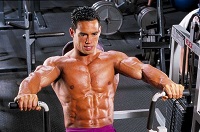 Physical activity helps distribute the extra calories from a heavy meal into the muscles instead of into the fatty tissue under the skin and around the internal organs.
Physical activity helps distribute the extra calories from a heavy meal into the muscles instead of into the fatty tissue under the skin and around the internal organs. Coaches identify 3 areas in which it may be difficult to gain weight
- Avoid fat deposits. Enhanced nutrition leads to the fact that calories that are not used up for muscle work and the formation of muscle tissue turn into body fat. To avoid this, regular training 3 times a week is necessary. Example exercises are described below.
- Avoid addiction when training no longer leads to muscle growth. The reason for adaptation is a protective mechanism that allows you to adapt to new living conditions. Unfortunately, it works against muscle building people. The body adapts to exercise in 4-8 weeks, as a result, the anabolic effect, which provides weight gain, is significantly reduced. Our methodology takes this feature into account, so you will be offered 5 training options with a gradual increase in loads, which will ensure stable muscle growth.
- Break the genetic threshold. At the initial stage, weight gain is stable, but then the increase stops, despite diet and training. It's a matter of genetics. You may have reached your optimal weight. To overcome the threshold, the drop-set method is effective. You perform a large number of repetitions with a large working weight. Further, the weight is reduced by 20-30% and the maximum number of repetitions is performed at a slow pace.
Key questions at the start of the program
- How do muscles grow? Muscle growth is provided by two types of stress. If they act in pairs, then the muscles increase in volume.
- mechanical stress. Significant efforts lead to the fact that individual muscle fibers are torn. Around them, microscopic foci of inflammation are formed, metabolism is activated and blood supply improves. Growing together, these microtears lead to an increase in muscle volume. Mechanical stress occurs during exercises with a large working weight (the weight of the projectile with which the exercise is performed).
- metabolic stress- during prolonged training, anaerobic metabolic products (lactic acid) accumulate in the muscles. To neutralize them and remove them from the body, an increased amount of oxygen enters the muscles and their nutrition improves. A sign that a muscle is under metabolic stress is a burning sensation. Occurs when the exercise is repeated at a slow pace for a long time. Starting the chemical recovery processes stimulates muscle growth.
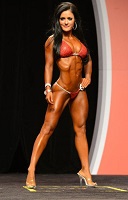
- Power training. Especially squats and deadlifts.
- Balanced diet - meat, seafood, greens, fruits, vegetables.
- Compliance with the daily routine. Sleep deprivation and exhaustion lower testosterone levels.
- The fight against stress. Strong emotions increase the level of the hormone cortisol, which suppresses the secretion of testosterone.
- Refusal of alcohol and nicotine. They impair blood circulation and suppress the work of the endocrine glands.
- Taking vitamins A, E, D. Their deficiency inhibits the production of testosterone.
- Outdoor recreation. Relaxation lowers cortisol levels. And sunlight increases the level of vitamin D and stimulates the ovaries, which are responsible for the synthesis of testosterone.
- Omega-3 and Omega-6 fatty acids, tinctures of ginseng and eleutherococcus, zinc and selenium - together and separately increase testosterone levels. These substances are sold in pharmacies and are part of various dietary supplements.
A set of exercises for the 1st and 2nd weeks of training
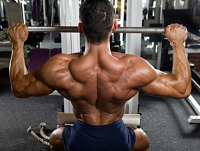 The program is designed for 3 workouts per week. Between trips to the gym should be at least 48 hours. Recommended time: Monday, Wednesday, Friday, but you can change it at your discretion.
The program is designed for 3 workouts per week. Between trips to the gym should be at least 48 hours. Recommended time: Monday, Wednesday, Friday, but you can change it at your discretion. The basis of training - clusters. These are sets of a certain number of repetitions that allow you to load the target muscles for longer. For this purpose, exercises are performed in cycles. Therefore, in the program you will see the alternation of exercises.
Important! Perform all exercises without jerking at a slow pace. So you achieve the necessary mechanical tension in the muscles and involve all the muscle fibers. The result is a high level of protein synthesis necessary for muscle growth.
Start every workout with a warm-up. Spend the first 5-10 minutes warming up your muscles so that they receive oxygen and nutrients. This will reduce the risk of injury and sprains, help you set yourself up for strength training, and also cause an adrenaline rush, which makes training more effective. For a warm-up, cardio equipment and complex exercises that involve the maximum number of muscles are suitable. An obligatory element is rotation in all joints of the spine, arms and legs.
First workout
- Squats with a barbell on the shoulders 4 * (4 * 2). Total 32 squats . Basic exercise for the development of the muscles of the buttocks and thighs.
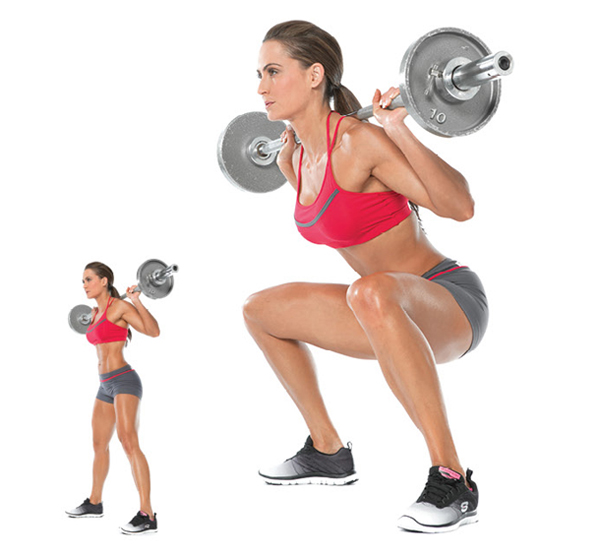 cluster (alternating approaches and short rest)
cluster (alternating approaches and short rest) 2 barbell squats. Put the barbell - rest 15 seconds.
2 squats + rest 15 sec.
2 squats + rest 15 sec.
2 squats + rest 15 sec.
Rest 1-2 minutes
2 repeat cluster
Rest 1-2 minutes
3 repeat cluster
Rest 1-2 minutes
4 repeat cluster
Rest 1-2 minutes
- Bent over row 4*(4*2). The exercise is designed to strengthen the muscles of the back, especially the latissimus dorsi.
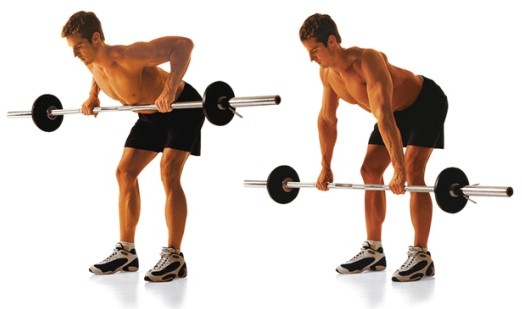 1 cluster
1 cluster Bent Over Row 2x + rest 15 sec.
Bent Over Row 2x + rest 15 sec.
Bent Over Row 2x + rest 15 sec.
Rest 1-2 minutes
2 repeat cluster
Rest 1-2 minutes
3 repeat cluster
Rest 1-2 minutes
4 repeat cluster
Rest 1-2 minutes
- Bench press (3*6).
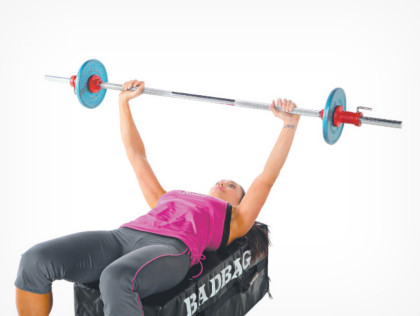 Provides an increase in the anterior bundle of the deltoid muscles, triceps, large and small muscles of the chest. For beginner athletes, the option is more suitable when, in the lower position above the chest, the bar falls on the limiters.
Provides an increase in the anterior bundle of the deltoid muscles, triceps, large and small muscles of the chest. For beginner athletes, the option is more suitable when, in the lower position above the chest, the bar falls on the limiters. 1st approach
- Lifting the bar for biceps in a standing position (3*6).
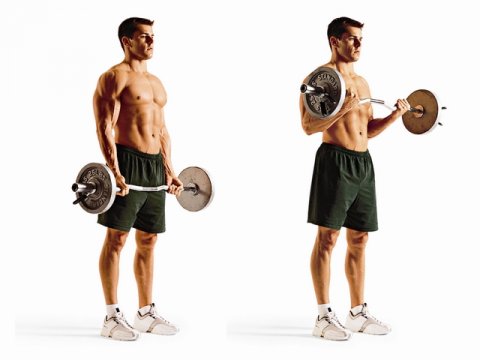 Helps to increase the biceps and brachioradialis muscle of the forearm.
Helps to increase the biceps and brachioradialis muscle of the forearm. 1st approach
- Bench press (3*6)
Bench press 6 times + rest 1-2 minutes
- Lifting the bar for biceps while standing (3*6)
6 times lifting the bar for biceps standing + rest 1-2 minutes
- Bench press (3*6)
Bench press 6 times + rest 1-2 minutes
- Lifting the bar for biceps while standing(3*6)
6 times lifting the bar for biceps standing + rest 1-2 minutes
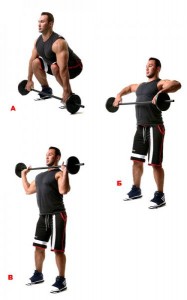 Involves a large group of muscles: trapezius, anterior and lateral bundles of the deltoid muscle.
Involves a large group of muscles: trapezius, anterior and lateral bundles of the deltoid muscle. 1st approach
- Regular GHR(3 * max.) Better than other exercises, it trains the muscles of the back of the thigh ("biceps" of the thigh), semitendinosus and calf. You can not do without an assistant who must press the toes of your feet to the floor. Technique: Get on your knees. Arms bent at the elbows, palms at shoulder level. Slowly, without jerking, lower yourself face down. Return to starting position.
- High pull (power pull) with a bar from the floor (3*5)
5 times high pull with a barbell from the floor + rest 1-2 minutes 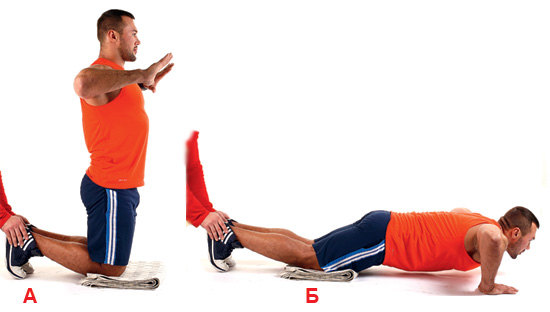 2nd approach
2nd approach
Perform the maximum number of times + rest 1-2 minutes
- High thrust (power traction) with a bar from the floor(3*5)
5 times high pull with a barbell from the floor + rest 1-2 minutes
- Regular GHR(3*max)
Perform the maximum number of times + rest 1-2 minutes 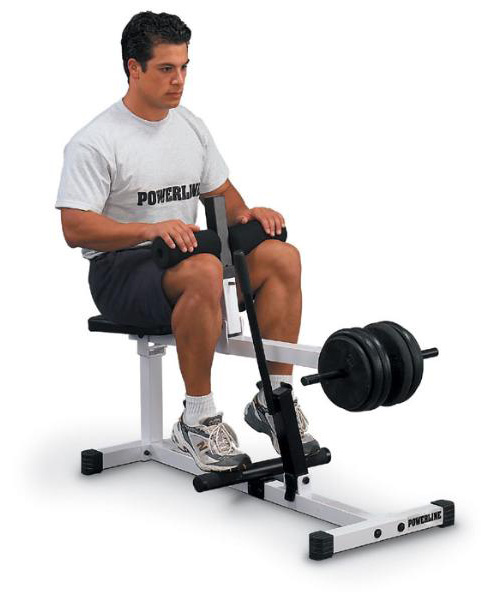
1st approach
2nd approach
20 times lifting on toes + rest 15 sec.
3rd approach
20 calf raises + rest 1-2 minutes  1st approach
1st approach
2nd approach
Max reps + 15 sec rest.
3rd approach
Maximum reps + rest 1-2 minutes.
Second workout
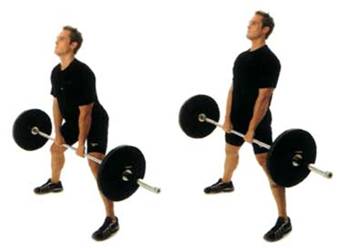 1st approach
1st approach - Shrugs standing with dumbbells(3*8) train top trapezoidal muscles, improve posture and are especially useful if you have a sedentary job.
- (4*6)
6 times knee row + rest 1-2 minutes
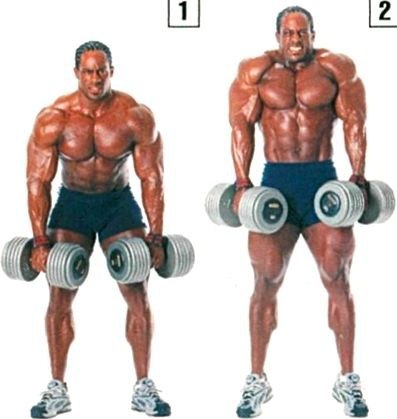 2nd approach
2nd approach 8 shoulder raises + rest 1-2 minutes
- Deadlift from knee level (4*6)
6 times knee row + rest 1-2 minutes
- Shrugs standing with dumbbells (3*8)
8 shoulder raises + rest 1-2 minutes
- Deadlift from knee level (4*6)
6 times knee row + rest 1-2 minutes
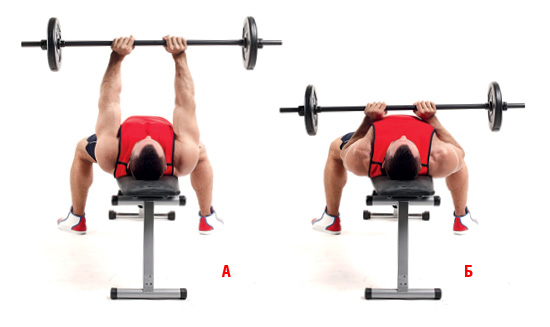 1st approach
1st approach 5 presses + rest 1-2 minutes
- Fitball push-ups(3*8). Complicated version of push-ups. If at the top point you spread the shoulder blades away from the spine, then you work out the anterior serratus muscle (Serratus Anterior), which is located on the side wall of the chest.
- Close Grip Bench Press (3*5)
5 presses + rest 1-2 minutes
- Fitball push-ups (3*8)
8 pushups + rest 1-2 minutes
- Close Grip Bench Press (3*5)
5 presses + rest 1-2 minutes
 3rd approach
3rd approach 8 pushups + rest 1-2 minutes
- (3*8). Develops the muscles of the lower back, buttocks and thighs. Legs in forward lunge position. It is important that the thigh of the bent leg is parallel to the floor.
- Pull-ups to the chest with a wide grip, when the distance between the hands is 70-80 cm. (3 * max.) Exercise helps to increase the volume of the latissimus dorsi, deltoid and serratus muscles, lower and middle parts of the trapezius muscles, as well as biceps and forearms, back muscle bundles.
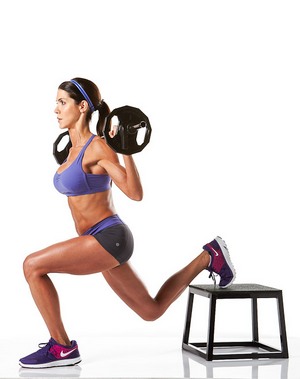 2nd approach
2nd approach 8 barbell squats + rest 1-2 minutes
- Pull-ups to the chest with a wide grip(3*max)
Maximum number of pull-ups + rest 1-2 minutes
- The simplest split squat with a barbell on the back (3*8)
8 barbell squats + rest 1-2 minutes
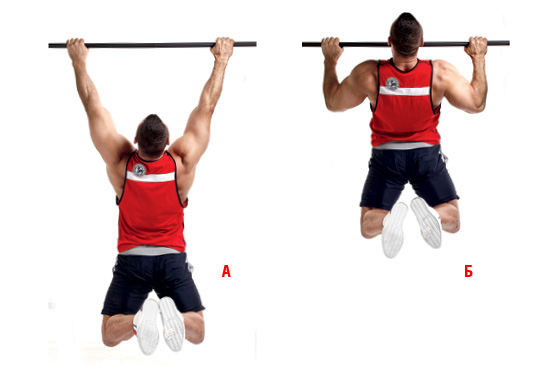 3rd approach
3rd approach Maximum number of pull-ups + rest 1-2 minutes
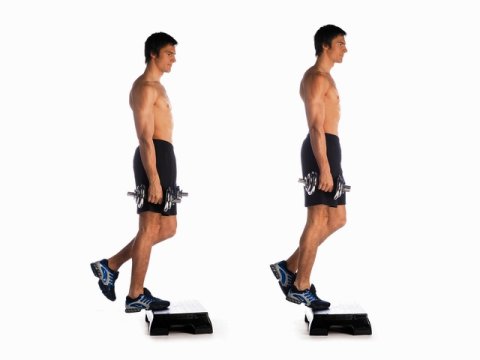 1st approach
1st approach 15 lifts + rest 15 sec.
2nd approach
15 lifts + rest 15 sec.
3rd approach
15 lifts + rest 1-2 minutes
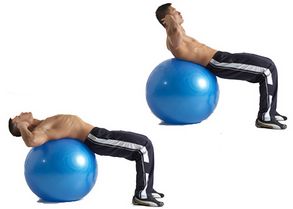
1st approach
2nd approach
The maximum number of twists + rest 15 sec.
3rd approach
The maximum number of twists + rest 1-2 minutes.
Third workout
 1 cluster
1 cluster 2 presses + rest 15 sec.
2 presses + rest 15 sec.
2 presses + rest 15 sec.
2 presses + rest 1-2 minutes
Rest 1-2 minutes
2 repeat cluster
Rest 1-2 minutes
3 repeat cluster
Rest 1-2 minutes
4 repeat cluster
Rest 1-2 minutes
- Pweighted reverse grip pull-ups 4*(4*2).
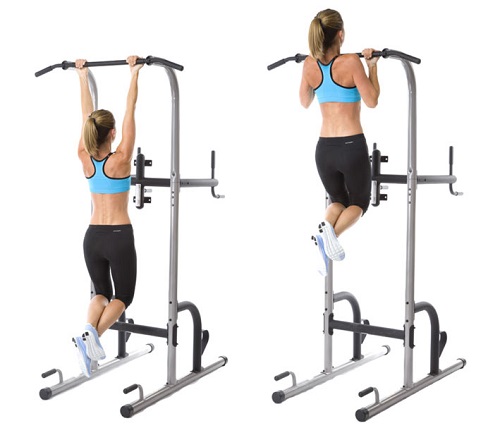 With a narrow grip, you increase the load on the biceps and lower bundles of the latissimus dorsi, and with a wide grip, on the latissimus dorsi. If physical strength does not allow you to perform the exercise with an additional load attached to the belt, then perform regular pull-ups.
With a narrow grip, you increase the load on the biceps and lower bundles of the latissimus dorsi, and with a wide grip, on the latissimus dorsi. If physical strength does not allow you to perform the exercise with an additional load attached to the belt, then perform regular pull-ups. 1 cluster
2 pull-ups + rest 15 sec.
2 pull-ups + rest 15 sec.
2 pull-ups + rest 15 sec.
Rest 1-2 minutes
2 repeat cluster
Rest 1-2 minutes
3 repeat cluster
Rest 1-2 minutes
4 repeat cluster
Rest 1-2 minutes ![]() Provides growth of the biceps of the thighs and buttocks, as well as the rectus and oblique abdominal muscles.
Provides growth of the biceps of the thighs and buttocks, as well as the rectus and oblique abdominal muscles.
1st approach
10 barbell lifts + rest 1-2 minutes
- (3*6)
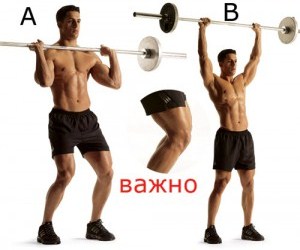 Provides development of the deltoid muscles and triceps. The muscles of the calves, thighs and buttocks receive an indirect load. Please note that the bar is supported by the chest, and not by the anterior bundles of the deltoid muscles.
Provides development of the deltoid muscles and triceps. The muscles of the calves, thighs and buttocks receive an indirect load. Please note that the bar is supported by the chest, and not by the anterior bundles of the deltoid muscles. 1st approach
- (3*10)
- Standing barbell push press (chest press with pressure at the top) (3*6)
6 barbell presses + rest 1-2 minutes.
- Romanian deadlift with barbell (3*10)
10 barbell lifts + rest 1-2 minutes.
- Standing barbell push press (bench press with pressure at the top point) (3*6)
6 barbell presses + rest 1-2 minutes
- (3*6).
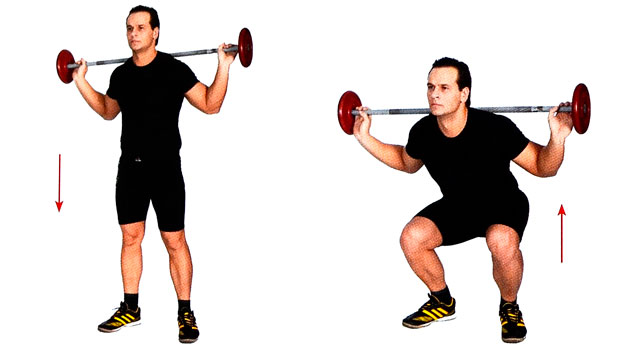 The main load falls on the muscles of the pelvis, hips and lower back, most of the muscles of the body are also involved.
The main load falls on the muscles of the pelvis, hips and lower back, most of the muscles of the body are also involved. 1st approach
- (3 * 12) works mainly on the biceps of the shoulder.
- Squats with a barbell on the trapezius muscles(3*6)
6 squats + rest 1-2 minutes.
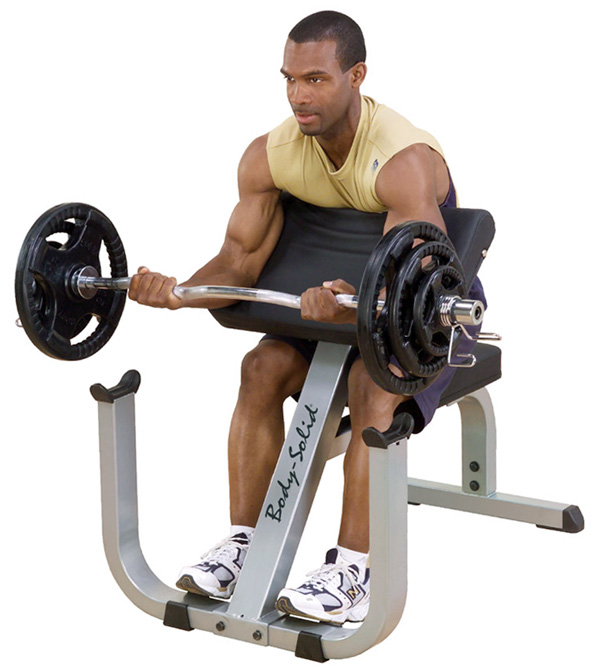 2nd approach
2nd approach 12 lifts + rest 1-2 minutes.
- Squats with a barbell on the trapezius muscles (3*6)
6 squats + rest 1-2 minutes.
- Sitting barbell curls (3*12)
12 lifts + rest 1-2 minutes.
- Seated calf raises (with back support)(3*30) work on increasing the soleus and gastrocnemius muscles on a simulator that provides back support.
30 lifts + rest 15 sec.
2nd approach
30 lifts + rest 15 sec.
3rd approach
30 lifts + rest 1-2 minutes.
- Lateral hyperextensions (twisting) with weights (3*12).
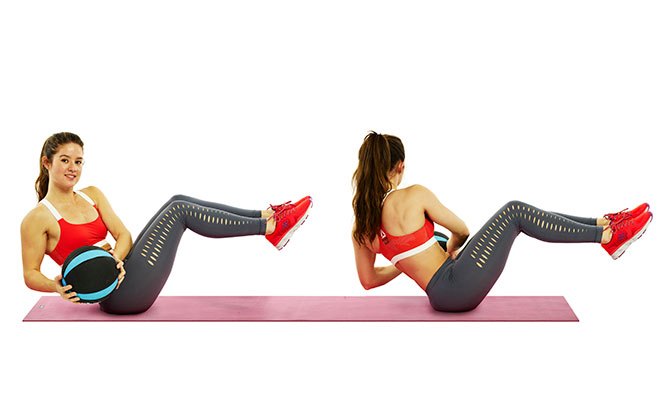 To increase the load on the oblique and intercostal muscles, dumbbells or a disk from the bar are used. For beginner athletes, an additional weight of 5 kg is sufficient.
To increase the load on the oblique and intercostal muscles, dumbbells or a disk from the bar are used. For beginner athletes, an additional weight of 5 kg is sufficient. 1st approach
2nd approach
12 crunches + rest 15 sec.
3rd approach
12 twists + rest 1-2 minutes.
After each workout, you will feel severe weakness and increased appetite. These signs indicate that the training was successful and the muscle growth processes are running.
Exercise Safety
- Work with an insurance partner.
- Before training, do a warm-up that involves all joints and muscle groups.
- Keep a moderate pace. Thus, you work out the muscles better.
- Don't jerk. In this case, the joints of the limbs and intervertebral joints (especially in the lumbar region) may suffer.
- Listen to the instructions of the trainer, especially regarding the technique of the exercise. Minor deviations from the technique, such as back arching, elbows apart, or bending of the knees, can lead to serious injury.
- Do not rush to perform exercises at the level of experienced athletes. They are protected by powerful muscles and strong tendons, you will acquire such protection in a few months.
Beginner Program
If you have a significant deficiency of mass, then devote the first 2-3 weeks to a set of kilograms. During this period, gradually increase the amount of food consumed and physical activity. Enough 5-7 minutes of gymnastics 2 times a day and walking in the fresh air for 60 minutes. After you have added 1-2 kg, you can start training.If you have not done sports regularly before, then a program designed for experienced athletes will not suit you. Exercises with a significant working weight (dumbbells and barbells) will be exhausting for you. During exercise, all extra calories will be burned, and weight gain will be too slow.
In this case, a simplified version of the workout that you can do at home is suitable. The regime is the same - 3 workouts per week with breaks of 72 hours.
Each workout includes:
- Push-ups from the floor 3 sets with the maximum number of repetitions.
- Pull-ups 3 sets with the maximum number of repetitions.
- Lunges back 3 sets of 10 reps.
- Hyperextensions 3 sets of 10-15 reps.
- Twisting 3 sets with the maximum number of repetitions.
Daily regime
 Why is it needed?
Why is it needed?Your body likes to follow a routine. If you adhere to the correct daily routine, this always leads to an improvement in the functioning of the nervous system, strengthening the immune system and normalizing body weight.
It is desirable that everything happens at the same time. Constancy stabilizes the body's biorhythms, which directly affects the production of hormones involved in mass gain. Eating by the clock normalizes metabolism and maintains a high level of anabolism. Sufficient rest protects the nervous system from stress, which regulates all processes in the human body. Overwork and exhaustion of the central nervous system often causes weight loss on a nervous basis.
Ideally, you should spend:
- 8 hours for work or study;
- 8 hours for rest and household chores;
- 8 hours sleep.
The increase in muscle mass does not take place during training, but during muscle recovery during the rest period. Therefore, the muscles must be able to recover. This period takes 48-72 hours. Based on this, training should be followed by 2-3 days of rest.
In your free time, avoid intense and prolonged physical activity: cycling, brisk walking, volleyball, basketball. They increase stress in the muscles and slow down their recovery.
Get at least 8-10 hours of sleep per day. And it is desirable to go to bed before 23 hours. In this case, during the sleep period, the active production of growth hormone falls, the muscles recover more efficiently and increase their mass. Lack of sleep impairs the synthesis of anabolic hormones and increases the production of cortisol. This substance reduces the rate of formation of muscle tissue, and enhances catabolism. It has been proven that sleeping less than 6 hours a day depletes the nervous system, which impairs muscle innervation and leads to weight loss.
A complete night's sleep is extremely important, especially on the days after training. In a dream, the synthesis of testosterone and insulin occurs, without which it is impossible to gain muscle mass. Also, 90% of the growth hormone - somatotropin is secreted during sleep between 23:00 and 01:00. This substance in young people provides bone growth, and in adulthood is responsible for protein synthesis and increases the ratio of muscle tissue to fat.
Is daytime sleep good? Sleeping during the daytime is not as useful for mass gain, as it does not cause the desired hormonal response. The fact is that hormones are synthesized in the 3rd and 4th phases of sleep, which are usually not achieved during daytime rest.
When is the best time to exercise?
The training schedule largely depends on your work schedule and biorhythms. Some prefer to go to the gym in the morning when there are fewer visitors. This makes it possible not to stand in line for shells, it is better to concentrate on the exercises and complete the workout faster. However, sports doctors believe that in the morning the muscles are not fully awake, so they do not work at full strength. This problem can be circumvented by intensive charging.
Evening workouts have their benefits. So some are motivated by the presence of numerous visitors in the hall, especially of the opposite sex. In addition, after a late workout, the muscles get a good rest during the night's sleep.
As you can see, the choice of time is an individual matter. The main thing is to engage persistently and with pleasure, then training will definitely give the desired result.
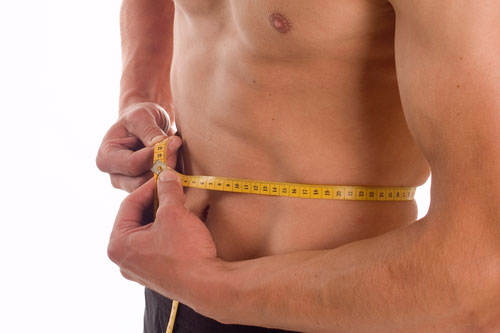 | In order to go to the weight gain program for 3-4 weeks, click on the link: |


